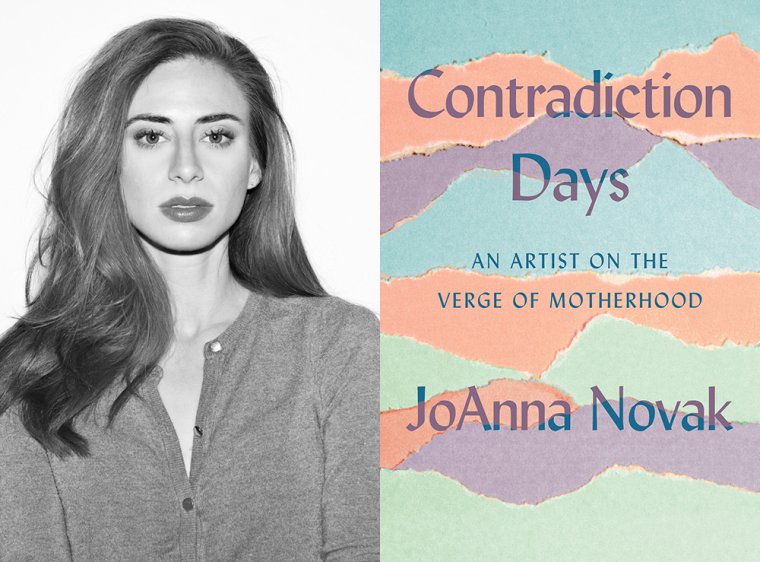This week’s installment of Ten Questions features JoAnna Novak, whose memoir, Contradiction Days: An Artist on the Verge of Motherhood, is out today from Catapult. In this mix of personal narrative and meditation on the painter Agnes Martin, Novak reckons with the transformation of her body and mind during pregnancy and what it means to be a female artist. As Novak finds herself overwhelmed by her changing physical state and lack of creative motivation, mental health problems come bubbling to the surface. When an attempt to seek medical advice results in her doctor admonishing her, she finds herself sinking into despair. Yet her engagement with Martin—particularly the painter’s struggle to make art while living with schizophrenia—opens a channel for Novak to find equilibrium and new inspiration. Seeking both communion with Martin and a new perspective, she travels to Martin’s longtime home in New Mexico and shuts herself off from the world for several weeks of introspection and writing. Kirkus praises Contradiction Days, saying “the story pulses with honesty and vulnerability, spiraling to a satisfying ending.” JoAnna Novak’s story collection, Meaningful Work (Fiction Collective 2, 2021), won the Ronald Sukenick Innovative Fiction Contest. She is the author of three books of poetry, most recently New Life (Black Lawrence Press, 2021), and a novel, I Must Have You (Skyhorse, 2017). Her work has appeared in the New York Times, the New Yorker, the Paris Review, and other publications.

JoAnna Novak, author of Contradiction Days: An Artist on the Verge of Motherhood. (Credit: Falyn Huang)
1. How long did it take you to write Contradiction Days?
I wrote the first draft in seventeen days. The subsequent drafts were rewrites. I wrote the first revision in four months. I wrote the second revision in six months. I wrote the third revision in seven months. I wrote the fourth revision in twenty-one days. This began in July 2019 and concluded in March 2022.
2. What was the most challenging thing about writing the book?
At first, writing with some degree of authority or confidence about Agnes Martin: putting that unspeakable connection—aesthetic, biographical, psychical—into words. Once I got over that hurdle, sitting with the person I’d been as the protagonist of the memoir and offering her compassion became the greater challenge.
3. Where, when, and how often do you write?
In a notebook, on the computer, or on my typewriter, a mint-green Hermes Media 3. At my desk, at the kitchen table, on the Amtrak, on benches in galleries, in museum bathrooms, at the library, once every few years at a bar having a glass of wine on an empty stomach, in hotel rooms.
I go through phases of writing first thing in the morning—4:00 AM until 7:00 AM, maybe. And when I’m on a deadline, I’ll write until two or three in the morning. (Last night I pressed send on something at 2:25 AM.) In a perfect world, I’d write all day, with lots of wheel-spinning in the morning that gives way to a hyper-focused afternoon that invites some after-dinner work. This is very infrequently achievable because I have an almost-four-year-old!
4. What are you reading right now?
Abbe Rivaux’s biography of Mother St. John Fontbonne. Caroline Knapp’s Pack of Two: The Intricate Bond Between People and Dogs. Henry Hoke’s Open Throat.
5. Which author or authors have been influential for you, in your writing of this book in particular or as a writer in general?
Agnes Martin’s writing was critical to my writing of this book, not only for its role in the plot but for its lessons in firmness, warmth, and clarity. I read most of John Berger as I wrote the third draft. The poems of Yi Sang. Annie Dillard, Anne Lamott, and Natalie Goldberg. Stephen Batchelor. Shunryū Suzuki.
6. Would you recommend writers pursue an MFA?
Yes, if it’s paid for. Or, if it costs money: Don’t compromise your daily survival.
7. What is one thing that surprised you during the writing of Contradiction Days?
How about two things? While I was working on the final rewrite, I interviewed a number of women who’d known Agnes Martin. Her friends, her colleagues, artists like Ann Martin and Lizzie Borden and Pat Steir. Their generosity astonished me. And then there’s a moment in the memoir when the narrator watches old interviews with Agnes, sees her and hears her voice in a very intimate viewing situation. The potency of that experience still shocks me.
8. If you could go back in time and talk to the earlier you, before you started Contradiction Days, what would you say?
You have time.
9. What forms of work, other than writing, did you have to do to complete this book?
Definitely research. I started reading about Agnes a couple of months before I wrote the first draft in Taos, New Mexico, and I continued for the next three years. Conducting interviews. Taking art history courses. Looking at as much art as I could. Also: having a baby, becoming a mother, and witnessing my priorities shift.
10. What’s the best piece of writing advice you’ve ever received?
It’s not a neat pull quote, but my first fiction-writing professor, Barbara Tannert-Smith, was always trying to get me to work in scenes. She told me to think of scenes as boxes. Discrete boxes, with their own contents—characters, action, setting, etcetera. That analogy has only become more helpful as I’ve continued writing. The containment of a scene can be a powerful source of tension and driver of plot. And it helps me stay grounded and forward-moving, especially when I’m working in flashback or deep interiority. Thank you, Barbara! I wrote the first draft of Contradiction Days in text boxes of 6 x 6 inches.








